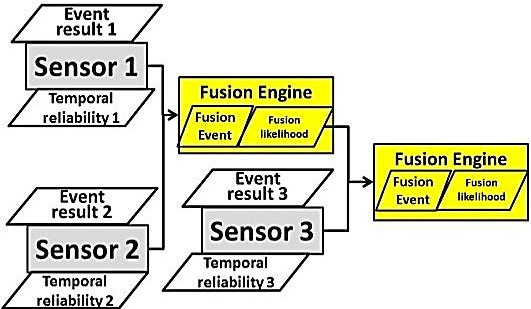Section: New Results
A Framework for Activity Detection of Older People Using Multiple Sensors
Participants : Carlos F. Crispim-Junior, Qiao Ma, Baptiste Fosty, François Brémond, Monique Thonnat.
keywords: model-based activity recognition, multi-sensor, Dempster-Shafer, Evidence Theory, older people.
We have extended our framework for multi-sensor activity detection by proposing a probabilistic approach for mutually exclusive activity conflict scenario. The proposed approach pre-learned a coefficient of reliability of each sensor with respect to each activity. The combination of the activities detected by multiple sensors is performed using the Dempster-Shafer evidence theory with an adapted combination rule based on runtime data from the sensor and the pre-computed coefficients of reliability. The combination of activities detected by multiple sensors can be performed in an iterative fashion taking into account several sensor contributions (see Fig.37 ). Tab. 5 presents the early results of the proposed probabilistic method at combining activities detected using RGB and RGB-D cameras. Results are presented individually for each camera and for the proposed approach.
The proposed fusion scheme performs better than the camera individual process in most of cases even in the presence of noise (see the RGB-D individual result of sensitivity for standing posture detection). The complete evaluation of the proposed approach is published in [43] . The developed probabilistic approach is now integrated into our previously developed framework for multi-sensor activity modeling. The new framework version allows experts to precisely define the sensors which will be used to detect each activity, or to automatically (and then probabilistic) combine multiple instances of (conflicting) activities detected by different sensors. The new framework proposal for multi-sensor activity detection has been published in [37] .


